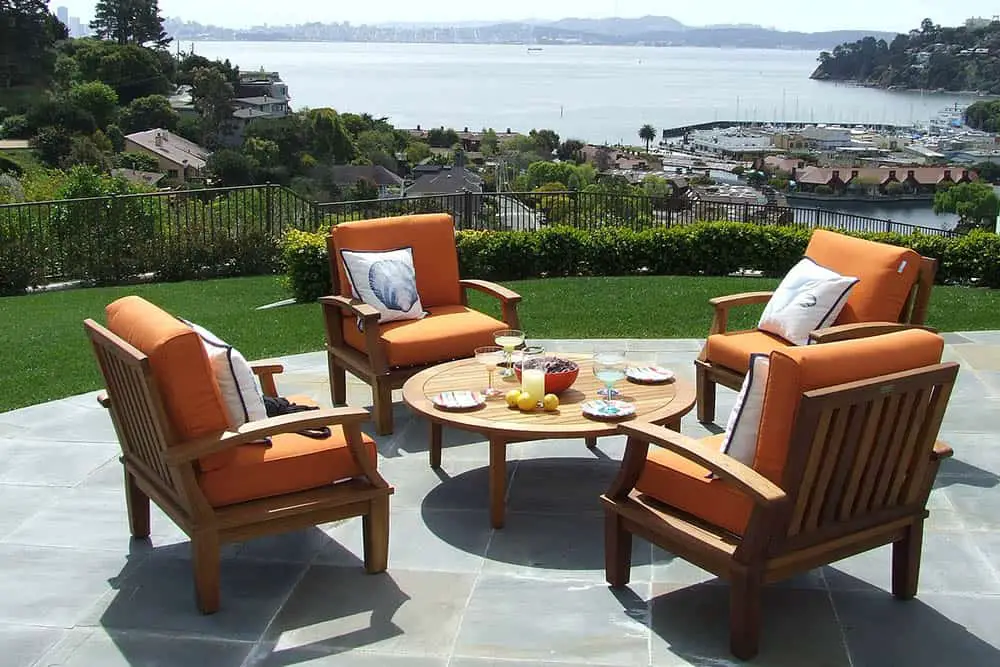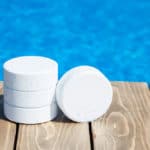Many people buy outdoor furniture without giving much of a thought to maintenance, but if you want your wooden furnishings to last out there in the great outdoors, an oil routine is essential.
The benefits of a light coating of oil are three-fold. Firstly, it protects the finish of the wood from stains. So, if you enjoy a glass of red by sun or moonlight, unless you’re going for a deep cherry wood look, oiling your furniture is essential.
Another benefit of greasing up that patio set is that it rehydrates the wood and provides UV protection. With the sun beating down on it day in day out, it won’t be long before it’s dry as a haystack.

Dehydration compromises the structural integrity of wooden furniture, diminishing its flexural strength. This is why oiling outdoor chairs is important. The last thing you want is to end up on your bum in a pile of kindling.
The more a wood dries out, the more you’ll notice its color slipping away, leaving it with a rather pallid, gray complexion. It’s not a great look, but oil can fix this too.
Oftentimes, wooden furniture oil reinvigorates the surface, replenishing some natural color. It can also be bought tinted, which helps to customize or boost the color profile of your furniture.
A lick of oil can also be instrumental in fighting off fungal growth. As the oil treatment saturates the pores in the wood, moisture can’t get, and if moisture can’t get in, fungus can’t grow.
The truth is, we should even be oiling our indoor wooden furniture. It’s just a necessary part of wood maintenance, so it goes without saying that the furniture we expose to the elements needs a good once over from time to time.
Should You Oil Teak Garden Furniture?
The strongest and most durable of all hardwoods, teak is an amazing material for building outdoor furniture. It’s tough as nails, looks fantastic, and its natural rot-resistant properties mean it can handle a spot of weather too, but did you know, most of teak’s resilience is derived from its high natural oil content? If that’s not a feather in oil’s cap, we don’t know what is.
Despite the robust disposition, as teak ages and dehydrates, its natural oil reserves eventually run dry, so you will indeed need to give it a good oiling to reinvigorate and replenish its weather-resistant and load-bearing qualities.
Tung oil is a solid choice for the job, but there are plenty of specialized teak oils available too. They bring more UV protection to the table...literally, so if you live in a pleasant climate, or if your garden gets a lot of sun, it’s the perfect way of giving your teak furniture a bit of TLC.
How Do You Take Care of Outdoor Furniture?
As we’ve already discussed, oiling your outdoor wooden furniture is a great way to keep it sturdy and looking great, but there are actually two other forms of maintenance you can add to your routines.
First, let’s discuss oiling in more detail. You don’t have to oil outdoor furniture all that often. One coat is usually enough to give it protection for the near future, but you might need to adjust your schedule to suit the seasons or the climate as a whole.
In mild climates, you should only ever oil your wooden outdoor furniture once every three months - not bad, right? However, with such a large gap between oils, it’s easily forgotten, which is why we recommend logging your maintenance schedule on a calendar.
In more arid climates, you’ll need to increase the oil rate to at least once every two months, maybe even more depending on the forecast.
So, how do you go about oiling your furniture? Well, before we even pick up our paintbrush or spray can, we need to give the wood a good wipe down. Next, we need to cover metal fixtures with masking tape. Once that’s taken care of, take your brush or spray can and give the wood a thin and even coat of the oil - you won’t need much.
You can then leave the oil to soak into your furniture for ten minutes. It’s good practice to then give your furniture another wipe down with a clean cloth to make sure there’s no excess oil lingering on the surface. Now you can leave your furniture to dry overnight. It should be safe to sit on the following afternoon.
Another way you can take care of your outdoor furniture is by simply cleaning it. Using a cloth and warm soapy water, give it a good once over. This should dislodge any buildups of debris and remove light stains. To get rid of stubborn stains, you can use mild bleach and a soft brush. Just make sure your scrub with, rather than against, the grain.
The last bit of maintenance advice we can give you is to cover or store your outdoor furniture either when there’s some extreme weather on the way or if you don’t plan on using it for the time being.
Furniture covers are great as long as they’re not made of plastics, but finding your wooden things a place in a well-ventilated shed or garage is the best course of action.
What Oil is Best for Outdoor Wood Furniture?
There are currently three main types of oil used for outdoor furniture maintenance, so let’s discuss the pros and cons of each one…
Teak Oil
Teak oil is incredibly easy to work with, has a decent shelf life, and offers a ton of UV protection. It penetrates deep into thick woods, and it doesn’t splinter.
On the other hand, it lacks versatility in that it’s not suitable for many woods, it’s usually heavily tinted, and it can interfere with glue.
Tung
Tung oil is water-resistant, easy to apply, non-toxic, and expands and contracts along with wood, but it has difficulty permeating hardwoods, takes a while to dry, and has a comparatively short shelf life.
Danish
Danish oil offers great water, heat, and chemical resistance, it doesn’t tint the natural color of the wood, and it’s easy to apply, but it can only be used on bare wood, and it’s not as durable, meaning your furniture will require more treatments.






